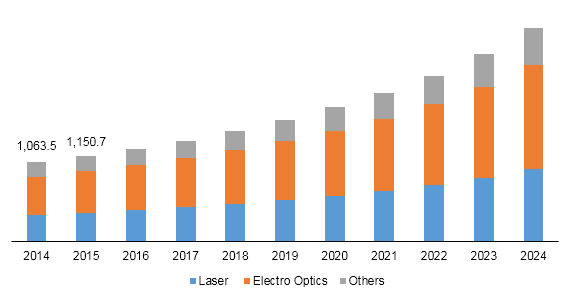
Lithium Tantalate Wafers Market Size And Forecast, By End Use (Laser Industry, Electronic Industry, Others), By Region (North America, Europe, Asia Pacific, Rest of the World), And Trend Analysis, 2014 - 2024
- Published: October, 2018
- Format: Electronic (PDF)
- Number of pages: 65
- Industry: Semiconductors & Electronics
Industry Insights
The global lithium tantalate wafers market size was valued at USD 1.36 billion in 2017. It is expected to exhibit a CAGR of 11.3% during the forecast period. The growth of the market can be attributed to growing applications of lithium tantalate wafers such as pyroelectric detectors, electro-optical waveguide, optical modulators, and piezoelectric transducers.
Global lithium tantalate wafers market revenue, by end use, 2014 - 2024 (USD Million)

High optical damage threshold and wide transparency range make the product well suited for numerous applications such as optical waveguide, wavefront distortion, surface acoustic wave (SAW) substrates, and piezoelectric transducers.
Lithium tantalate wafers are widely used in smartphone devices such as filters and oscillators. These wafers are integrated with surface acoustic wave (SAW) devices to serve as a noise barrier. Smartphone penetration will continue to increase across the world. More than one-third of the global population is expected to use a smartphone by 2018. For instance, in Asia Pacific, internet users in countries such as India, China, and Indonesia are expected to grow at an annual rate of 15.2%, 5.7%, and 10.6%, respectively.
Segmentation by End Use
• Laser Industry
• Electronics Industry
• Others
The laser industry segment was valued at USD 459.7 million in 2017. It is estimated to expand at a CAGR of 11.3 % over the forecast period. High repetition rate pulsed laser with high power has a wide range of end uses such as material processing, military end uses, laser ranging, bio-macromolecule material, medicine, and remote sensing. Fundamental properties such as wide transparency range, high electro-optic, and non-linear optical coefficients boosting the demand for lithium tantalite wafers in the laser industry.
The electronics industry segment was valued at USD 658.0 million in 2017. It is projected to exhibit a CAGR of 11.5 % during the forecast period. Technological advancements in integrated electronic circuitry are generating concepts to manufacture complete systems that possess signals at optical frequencies. Electronics has emerged as a key industry for various end uses such as signal processing for telecommunications and detectors.
Increasing use of lithium tantalate Q-switches in military and commercial end uses such as range finding, target designating, and ophthalmic surgery is anticipated to boost the growth of the others segment during the forecast period. Moreover, various research and development (R&D) activities are being carried out in the market. Several laboratories across the world are developing new devices using lithium tantalite for various end uses.
Segmentation by Region
• North America
• Europe
• Asia Pacific
• Rest of the World
Asia Pacific led the market in terms of revenue in 2017. The region is poised to maintain its dominance through 2024 owing to presence of numerous semiconductor industries in developing nations such as Taiwan, China, South Korea, and India. Japan is involved in research on piezoelectric materials to a greater extent than other countries.
Increasing adoption of lithium tantalate as a substrate in photonics is anticipated to drive the market in the region during the forecast period. In China, growing demand for fiber optics, large-scale production, and well-established telecom sector are augmenting the market.
North America accounted for a share of over 32.0% in 2017. Optoelectronic components are widely used in consumer electronics, healthcare, laser industry, and telecommunication, which is expected to drive the lithium tantalate wafers market. Robust growth of the optoelectronic components sector such as sensors, laser diode, and LED in the region is estimated to propel the market.
Europe accounted for 19.2% of the overall revenue. It is projected to register substantial growth during the forecast period owing to increasing technological advancements and product innovation in the fiber optic and telecommunication industries. Rising military spending by the governments of Russia, Germany, and U.K. is poised to promote use of piezoelectric materials over the forecast period.
Competitive Landscape
Players in the market are adopting strategies such as mergers and acquisitions (M&A) and partnerships in order to expand their business operations. Key players operating in the lithium tantalate wafers market include American Elements; CASTECH INC; The Roditi International Corporation; Oxide Corporation; Korth Kristalle GmbH; and United Crystals.
Industry regulations, government policies, and technological innovations are likely to increase the competition over the forecast period. However, companies are expected to shift their focus towards product innovation, which will provide them with a competitive advantage over competitors.
The lithium tantalate wafers market is marked by presence of a number of market players. Latest technological advancements are estimated to maintain intense competition in the arena.

Choose License Type
- World's largest premium report database
- Transparent pre & post sale customer engagement model
- Unparalleled flexibility in terms of rendering services
- Safe & secure web experience
- 24*5 Research support service
